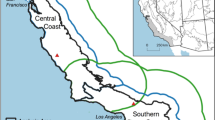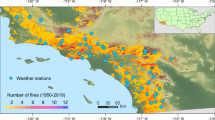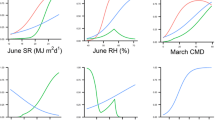Abstract
Large wildfire occurrence and burned area are modeled using hydroclimate and landsurface characteristics under a range of future climate and development scenarios. The range of uncertainty for future wildfire regimes is analyzed over two emissions pathways (the Special Report on Emissions Scenarios [SRES] A2 and B1 scenarios); three global climate models (Centre National de Recherches Météorologiques CM3, Geophysical Fluid Dynamics Laboratory CM2.1 and National Center for Atmospheric Research PCM1); three scenarios for future population growth and development footprint; and two thresholds for defining the wildland-urban interface relative to housing density. Results were assessed for three 30-year time periods centered on 2020, 2050, and 2085, relative to a 30-year reference period centered on 1975. Increases in wildfire burned area are anticipated for most scenarios, although the range of outcomes is large and increases with time. The increase in wildfire burned area associated with the higher emissions pathway (SRES A2) is substantial, with increases statewide ranging from 36% to 74% by 2085, and increases exceeding 100% in much of the forested areas of Northern California in every SRES A2 scenario by 2085.







Similar content being viewed by others
Notes
Comprehensive data prior to 1980 are not available from some of these sources. Fire data after 1999 are available, but the hydrologic simulations forced with historic climate data used here were developed for the California Scenarios Project, of which this research is a component. These data ended in 1999, so the common period of overlap between the available fire history and the hydroclimatic data was 1980–1999.
We show results for expected total area burned only, which are similar to predicted changes in large fire occurrence.
References
Balling RC, Meyer GA, Wells SG (1992) Relation of surface climate and burned area in yellowstone national park. Agric For Meteorol 60:285–293
Brillinger DR, Preisler HK, Benoit JW (2003) Risk assessment: a forest fire example. In Science and Statistics, Institute of Mathematical Statistics Lecture Notes. Monograph Series
Cayan D, Tyree M et al (2009) Climate Change scenarios and sea level rise estimates for the California 2008 Climate Change Scenarios Assessment, Public Interest Energy Research, California Energy Commision, Sacramento, CA
Cumming SG (2001) A parametric model of the fire-size distribution. Can J For Res 31:1297–1303
Gesch DB, Larson KS (1996) Techniques for development of global 1-kilometer digital elevation models. In Pecora Thirteen, Human Interactions with the Environment—Perspectives from Space. Sioux Falls, South Dakota, August 20–22, 1996
Hamlet AF, Lettenmaier DP (2005) Production of temporally consistent gridded precipitation and temperature fields for the continental U.S. J Hydrometeorol 6(3):330–336
Hansen MC, DeFries RS, Townshend JRG, Sohlberg R (2000) Global land cover classification at 1 km spatial resolution using a classification tree approach. Int J Remote Sens 21:1331–1364
Heyerdahl EK, Brubaker LB, Agee JK (2001) Factors controlling spatial variation in historical fire regimes: a multiscale example from the interior West, USA. Ecology 82(3):660–678
Hidalgo HG, Dettinger MD, Cayan DR (2008) Downscaling with constructed analogues: Daily precipitation and temperature fields over the United States. CEC Report CEC-500-2007-123. January 2008
Holmes TP, Hugget RJ, Westerling AL (2008) Statistical analysis of large wildfires. Chapter 4 of economics of forest disturbance: Wildfires, storms, and pests, Series: Forestry Sciences, Vol. 79. In Holmes TP, Prestemon JP, Abt KL (Eds), XIV, p 422. Springer. ISBN: 978-1-4020-4369-7
Kipfmueller KF, Swetnam TW (2000) Fire-climate interactions in the Selway-Bitterroot wilderness area. USDA Forest Service Proceedings RMRS-P-15-vol-5
Le Quéré C, Raupach MR, Canadell JG, Marland G (2009) Trends in the sources and sinks of carbon dioxide. Nat Geosci 2:831–836
Liang X, Lettenmaier DP, Wood EF, Burges SJ (1994) A simple hydrologically based model of land surface water and energy fluxes for general circulation models. J Geophys Res 99(D7):14,415–14,428
Malamud BD, Morein G, Turcotte DL (1998) Forest fires: an example of self-organized critical behavior. Science 281:1840–1842
Maurer EP, Hidalgo HG (2008) Utility of daily vs. monthly large-scale climate data: an intercomparison of two statistical downscaling methods. Hydrology and Earth System Science 12:551–563
Maurer EP, Wood AW, Adam JC, Lettenmaier DP, Nijssen B (2002) A long-term hydrologically-based data set of land surface fluxes and states for the conterminous United States. J Climate 15:3237–3251
Mitchell KE et al (2004) The multi-institution North American Land Data Assimilation System (NLDAS): Utilizing multiple GCIP products and partners in a continental distributed hydrological modeling system. J Geophys Res 109:D07S90. doi:10.1029/2003JD003823
Monteith JL (1965) Evaporation and the environment. Symp Soc Expl Biol 19:205–234
Penman HL (1948) Natural evaporation from open-water, bare soil, and grass. Proc R Soc Lond A193(1032):120–146
Preisler HK, Westerling AL (2007) Statistical model for forecasting monthly large wildfire events in the Western United States. J Appl Meteorol Climatol 46(7):1020–1030. doi:10.1175/JAM2513.1
Preisler HK, Westerling AL, Gebert KM, Munoz-Arriola F, Holmes T (2011) Spatially explicit forecasts of large wildland fire probability and suppression costs for California. International Journal of Wildland Fire 20:508–517
Preisler HK, Brillinger DR, Burgan RE, Benoit JW (2004) Probability based models for estimating wildfire risk. Int J Wildland Fire 13:133–142
Ricotta C, Avena G, Marchetti M (1999) The flaming sandpile: self-organized criticality and wildfires. Ecol Model 119:73–77
Schlobohm P, Brain J (2002) Gaining an understanding of the national fire danger rating system. National Wildfire Coordinating Group Publication: NFES # 2665. www.nwcg.gov
Schoenberg FP, Peng R, Woods J (2003) On the distribution of wildfire sizes. Environmetrics 14:583–592
Song W, Weicheng F, Binghong W, Jianjun Z (2001) Self-organized criticality of forest fire in China. Ecol Model 145:61–68
Stephenson NL (1998) Actual evapotranspiration and deficit: Biologically meaningful correlates of vegetation distribution across spatial scales. J Biogeog 25:855–870
Strauss D, Bednar L, Mees R (1989) Do one percent of the forest fires cause ninety-nine percent of the damage? Forest Sci 35:319–328
Swetnam TW, Betancourt JL (1998) Mesoscale disturbance and ecological response to decadal climatic variability in the American Southwest. J Clim 11:3128–3147
Theobald D (2005) Landscape patterns of exurban growth in the USA from 1980 to 2020. Ecol Soc 10(1):32
U.S. EPA (2008) Preliminary steps towards integrating climate and land use (ICLUS): The Development of Land-Use Scenarios Consistent with Climate Change Emissions Storylines (External Review Draft). U.S. Environmental Protection Agency, Washington, D.C. EPA/600/R-08/076A
Veblen TT, Kitzberger T, Donnegan J (2000) Climatic and human influences on fire regimes in ponderosa pine forests in the Colorado Front Range. Ecol Appl 10:1178–1195
Verdin KL, Greenlee SK (1996) Development of continental scale digital elevation models and extraction of hydrographic features. In: Proceedings, Third International Conference/Workshop on Integrating GIS and Environmental Modeling, Santa Fe, New Mexico, January 21–26, 1996. National Center for Geographic Information and Analysis, Santa Barbara, California
Westerling AL (2009) “Wildfires.” Chapter 8 in Climate Change Science and Policy. Schneider, Mastrandrea, Rosencranz and Kuntz-Duriseti (Eds), Island Press”Washington DC, USA
Westerling AL, Bryant BP (2008) Climate change and wildfire in California. Clim Chang 87:s231–249. doi:10.1007/s10584-007-9363-z
Westerling AL, Gershunov A, Cayan DR, Barnett TP (2002) Long lead statistical forecasts of Western U.S. Wildfire area burned. Int J Wildland Fire 11(3,4):257–266. doi:10.1071/WF02009
Westerling AL, Brown TJ, Gershunov A, Cayan DR, Dettinger MD (2003) Climate and wildfire in the Western United States. Bull Am Meteorol Soc 84(5):595–604
Westerling AL, Hidalgo HG, Cayan DR, Swetnam TW (2006) Warming and earlier spring increases Western U.S. forest wildfire activity. Science 313:940–943. doi:10.1126/science.1128834, Online supplement
Zhang Y-H, Wooster MJ, Tutubalina O, Perry GLW (2003) Monthly burned area and forest fire carbon emission estimates for the Russian Federation from SPOT VGT. Remote Sens Environ 87:1–15
Author information
Authors and Affiliations
Corresponding author
Electronic supplementary material
Below is the link to the electronic supplementary material.
ESM 1
(DOCX 176 kb)
Rights and permissions
About this article
Cite this article
Westerling, A.L., Bryant, B.P., Preisler, H.K. et al. Climate change and growth scenarios for California wildfire. Climatic Change 109 (Suppl 1), 445–463 (2011). https://doi.org/10.1007/s10584-011-0329-9
Received:
Accepted:
Published:
Issue Date:
DOI: https://doi.org/10.1007/s10584-011-0329-9




